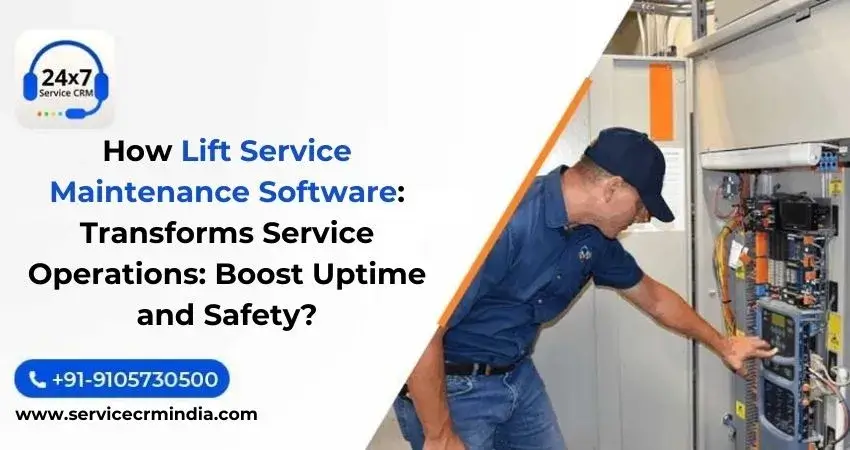
May 24, 2025
Lift or Elevators are the invisible engines of modern buildings—silently ferrying people and goods from floor to floor. When a lift malfunctions, it doesn’t just disrupt movement—it risks safety, tarnishes reputations, and impacts productivity. In today’s fast-paced, safety-conscious environment, lift service businesses or companies must rely on more than routine checks. They need smart, automated, and data-driven software systems to ensure optimal performance.
How Lift Service Maintenance Software Transforms Service Operations: Boost Uptime and Safety?
That’s where Lift Service Maintenance Software Service CRM comes in. More than just a digital calendar or database, modern solutions transform entire field service operations—boosting uptime, enhancing safety, real-time tracking, and improving customer satisfaction.
Let’s explore how this technology is reshaping the future of lift maintenance.
The Problem with Traditional Lift Maintenance Models
For decades, lift & elevator maintenance operated on a preventive or reactive model: schedule periodic inspections, respond when something goes wrong, and hope for the best in between. While this worked in the past, it’s no longer sufficient for high-demand commercial and residential settings where downtime and safety risks are unacceptable.
Common pain points include:
1. Missed or delayed service appointments
2. Poor tracking of service history
3. Manual paperwork and outdated logs
4. Limited visibility into recurring issues or parts usage
5. Difficulty managing technicians and work orders efficiently
Centralized Scheduling and Dispatch: No More Missed Service Calls
Smarter Resource Allocation
Lift & Elevator Maintenance Business Software Service CRM automates and streamlines scheduling by assigning jobs to technicians based on location, skill set, inventory management, urgency, and workload. It minimizes downtime and lowers customer complaints by making ensuring the appropriate professional is sent out at the appropriate time.
Real-Time Visibility
Real-time service status tracking is available to both dispatchers and clients. Notifications, reminders, and live updates keep all parties in sync, improving response time and accountability.
Enhanced Safety Through Digital Checklists and Compliance Tracking
Standardized Safety Protocols
Lift maintenance involves strict regulatory compliance and safety standards. Modern Service CRM software platforms come with pre-configured safety checklists and customizable forms that field technicians must complete digitally on-site. This ensures nothing is overlooked, and inspections are fully documented.
Audit-Ready Records
Every action—from inspection notes to replaced parts—is automatically recorded and time-stamped. This creates a transparent digital trail that simplifies audits, certifications, and legal compliance.
Predictive Maintenance: Fix Issues Before They Cause Downtime
IoT and Data Integration
IoT-enabled lifts can be integrated with certain sophisticated lift maintenance systems, which collect data from sensors that track performance in real-time. This allows companies to move from scheduled maintenance to predictive maintenance—fixing issues before they escalate into failures.
For example, rising motor temperatures or frequent door malfunctions can trigger alerts for preemptive servicing.
Reduced Emergency Repairs
Predictive insights drastically reduce emergency breakdowns and after-hours service calls, which are both costly and reputation damaging. With fewer surprises, companies can plan parts usage, field technician availability, and customer communications more efficiently.
Inventory and Parts Management: Always Have What You Need
Real-Time Spare Parts Tracking
When lifts or elevators go down, delays often stem from missing parts. Lift & Elevator Service Software Service CRM tracks inventory levels in real-time, ensuring that commonly used parts are always stocked across warehouses and service vans.
Automated Reordering and Vendor Integration
Set minimum thresholds for critical spare parts, and Service CRM software can auto-generate purchase orders or alert your procurement team. Some systems even integrate directly with vendors for automated restocking, saving time and avoiding stockouts.
Digital Work Orders and Mobile Access
Field Tech Empowerment
Technicians equipped with mobile apps can:
1. View assigned work orders
2. Access lift service history and manuals
3. Log maintenance notes and photos
4. Submit digital checklists and forms
5. Generate customer signatures and service reports
This reduces paperwork, improves accuracy, and speeds up reporting.
Instant Invoicing and Documentation
Once a job is completed, the system can generate bill invoices, email reports to customers, and update central records—cutting down admin work and shortening the payment cycle.
Reporting and Performance Analytics
Insights for Continuous Improvement
With everything centralized, managers can pull reports on:
1. Technician performance
2. Lift uptime vs. downtime
3. Recurring service issues
4. Parts usage trends
5. Customer satisfaction metrics
These insights help optimize staffing, plan capital expenditures, and improve service quality.
Why It Matters: Uptime, Safety, and Reputation?
Less Downtime, Happier Clients
Whether in a hospital, hotel, or high-rise office, lifts or elevators are expected to function seamlessly. By minimizing breakdowns and improving service speed, Service CRM Software helps maintain trust and tenant satisfaction.
Higher Safety Standards
Digital records, automated checklists, and predictive alerts reduce the risk of safety violations or mechanical failures—safeguarding both users and your field business.
Scalable Operations
Whether you manage 50 elevators or 5,000, modern Service CRM software makes it easier to scale operations without proportionally increasing administrative burden or error rates.
Final Thoughts: The Future of Lift Service Is Digital
Lift Service Maintenance Software Service CRM is no longer a tool just for efficiency—it’s a strategic asset. From maximizing uptime and ensuring safety to improving customer experience and compliance, these platforms help service providers thrive in a competitive market.
If your business and company still rely on manual tracking and outdated systems, the time to upgrade is now. The lift industry is rising fast—and your service business operations should rise with it.


